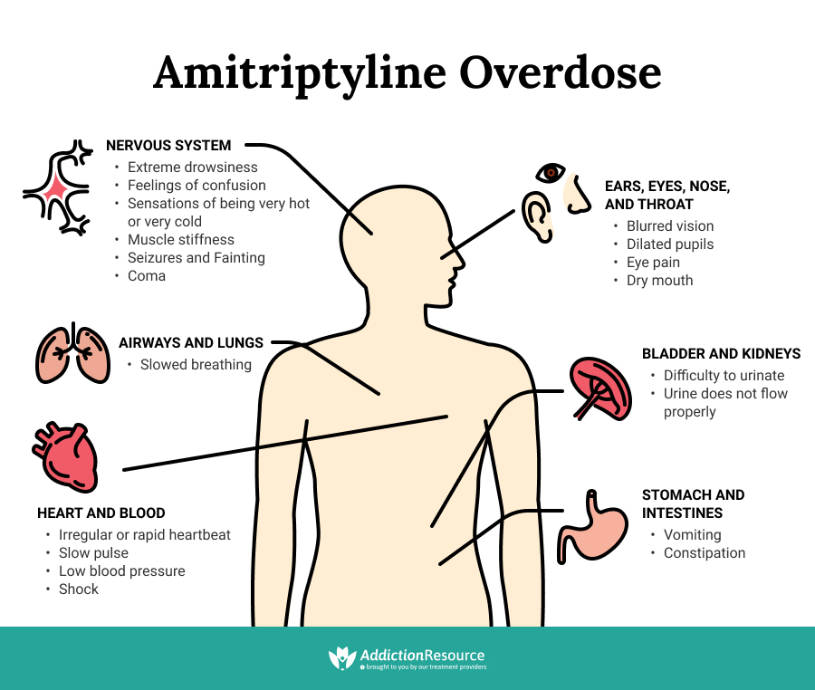Amitriptyline (brand name Elavil) is part of the nine tricyclic antidepressants, and its main use is for the treatment of mental health conditions, including depression. Additionally, Amitriptyline hydrochloride is also used to treat chronic pain, including nerve pain and migraine attacks.
Table Of Contents:
In 2019, over 5,000 deaths in the United States were reported due to antidepressants, and one of these drugs is the Elavil. One possible cause of these deaths is drug overdose, and this happens when someone takes larger doses or mixes the antidepressant with other substances, which can be serious and fatal. According to a clinical study, tricyclic antidepressant overdoses had higher rates of hospitalization and mortality compared to other antidepressant drug classes such as SSRIs (Selective Serotonin Reuptake Inhibitors). However, when taken as prescribed, there is a risk for someone to experience toxicity from Elavil.
In this article, information about the Elavil drug including the data and statistics of overdose, dangers, symptoms, how to avoid overdose, how much Amitriptyline is fatal, and Amitriptyline overdose treatment options will be provided.
Amitriptyline (Elavil) is a prescription medication for depression, and as with any medicine, there is concern about potentially overdosing on it. The question is if an overdose is possible on this specific drug. The answer is yes.
Data And Statistics on Antidepressants Overdose Issue in The USA
Drug overdoses occur when patients use more doses than recommended, and this can happen accidentally or intentionally. Accidental drug overdose happens when a patient experiences the following:
- Taking medicine by mistake – a patient, especially the older ones, have the tendency to forget that they have already taken the same drug.
- Relying on the internet – individuals may search about Elavil over the internet and solely rely on it about the proper usage of the drug. This may cause toxicity, especially when the inappropriate dosage is being consumed.
- Using the wrong medicine – sometimes, some patients may take the wrong medicines especially when there are labeling issues.
- Impaired individuals swallow medicines – a child or adult with impaired mental disabilities may grasp a certain medication and mistake it for a treat or sweets or taking them out of curiosity.
- Accident overdose during medical or surgical procedures
On the other hand, intentional drug overdose happens due to many factors, and some of these are because of problems, stress, or attempt to suicide. In fact, in 2019, excess consumption of drugs is one of the leading causes of death in the United States for individuals below 50 years old.
Currently, the United States is experiencing an epidemic of drug overdose deaths. In 2019, over 70,000 individuals, among all ages, have died in the United States due to drug overdose and around 5,000 of these individuals died specifically because of antidepressants. Additionally, 68% of these deaths occurred among males.
With regards to Amitriptyline overdose, according to an article, Elavil is one of the drugs that is associated with overdose deaths as this drug is mistakenly assumed to be safe without taking into consideration the proper dose recommendations. According to an article, Elavil is found to be responsible for the 145 deaths of individuals 12 years old and below from 2000-2004. In a clinical evaluation using 110 cases of overdose of Amitriptyline, it was reported that suicide attempts were common

Can One Overdose On Amitriptyline?
Amitriptyline (Elavil) is a prescription medication for depression, and as with any medicine, there is concern about potentially overdosing on it. The question is if an overdose is possible on this specific drug. The answer is yes. In fact, within 30 minutes of overdose, fatal toxicity effects such as altered mental state and tachycardia (faster heartbeat than normal) will be seen.
Taking too much Elavil than the recommended dose or mixing it with other substances that might potentiate it are common causes of Amitriptyline overdose. Although this may be intentional or not, the effects are life-threatening. Almost all of the individuals who consume too much of this drug need to be hospitalized in order to properly manage the symptoms and toxicity of the drug.
Amitriptyline Overdose Symptoms
Even if someone is not abusing Elavil, they should be aware of the Amitriptyline overdose symptoms. Being able to spot these symptoms themselves and others is critical in avoiding the worst possible circumstances. Keep in mind that, in some cases, these symptoms can mimic Amitriptyline adverse effects but are much more dangerous. So, whether they are side effects or toxicity symptoms, it is important to be familiarized with them. Symptoms vary from one person to another.
Below Is a Piece of Information About the Symptoms of Elavil Toxicity in Different Parts of the Body:
| Heart and Blood |
|
| Bladder and Kidneys |
|
| Airways and Lungs |
|
| Stomach and Intestines |
|
| Ears, Eyes, Nose, and Throat |
|
| Nervous system |
|
Once toxicity occurs, the signs and symptoms above may last for 24-48 hours. If any of these symptoms are observed in someone known to have taken Elavil or its generics, contact emergency services in order to properly manage the life-threatening effects of the drug.
Avoiding Amitriptyline Overdose: Dangers And Warnings to be Considered
Tricyclic antidepressants are used commonly in elderly patients to treat mental health problems, and these drugs are also being used as a sedative. However, these drugs are one of the frequently abused ones. Because of this, overdose can happen, and this may lead to dangerous events, including life-threatening ones.
Below Are Some Dangers of Elavil Toxicity:
- Fatal arrhythmia (too rapid or uncoordinated heartbeats that may lead to death)
- Myocardial infarction (heart attack)
- Prolonged cardiac arrest (abrupt loss of heart function)
- Refractory hypotension (blood pressure circulation cannot be maintained at a normal level causing it to be relatively lower than normal)
- Central Nervous System depression (happens when the body’s neurological normal function slows down)
When an overdose happens, cardiovascular toxicities are evident and can easily be seen. Additionally, it is important to know that this may cause coma, and it will take almost 7 days for a person to have Elavil concentration decline. Avoiding this is as important as treating it.
Below Are Some Tips and Ways on How to Avoid Elavil Overdose:
- Take note of the labels – always read the labels of the drugs before consuming them. It is important to keep all the medicines on their original packaging, and as much as possible, it is important to triple check the label before taking one.
- Take medicines as directed – avoid using Elavil more than the prescribed dose. It is very much important to only follow what is directed on the prescription. If a patient no longer needs a certain medicine but has more supplies of it, it is a must for that patient to return the medicines to the pharmacy.
- Keep out of reach of children – it is a must for parents and caregivers to keep out drugs/medicines, alcohol, and other substances out of reach of children. Keep these substances in a secured place.
- Take note of drug interactions – let your doctor know the medicines you take aside from Amitriptyline as it is possible for drug interactions to occur. Also, search and take note of other food-drug interactions such as alcohol-Elavil interaction as these may affect how the drug will properly work.
Aside from the tips above, it is also important to understand that the drugs a certain patient takes cannot be shared with other people. In case of overdose, contact emergency care services immediately as toxic effects of Amitriptyline overdose can develop rapidly.

The Risks of Poisoning After Overdose on Amitriptyline
Poisoning may happen when a patient consumes an excessive amount of a certain drug. Over the years, Tricyclic antidepressants, including Elavil are common causes of fatal drug poisoning in the United States.
Below Are Some Risks of Poisoning After Elavil Overdose:
- Pulseless vital signs
- Resistant arrhythmia (irregular heartbeat that is resistant to medications and DC shocks)
- Prolonged ventricular tachycardia (super fast heart rhythm)
- Cardiac arrest
- Unrecordable blood pressure
- Global hypokinesia (relatively low movements)
- Pulmonary edema (excess fluids in the lungs)
- Hypotension (low blood pressure than normal)
- Hemodynamic instability (inadequate blood flow to organs)
When a patient has been poisoned after an Amitriptyline overdose, a hospitalization time of 4 days to 1 week, depending on the severity of the case, will be needed. Incorporation of antidotes, intubation, and even resuscitation will be done if needed. When there is a suspected poisoning, it is a must to call Poison Control to properly manage the case.
Elavil Overdose as a Result of Drugs Interaction
Taking too much medicine can cause harm and toxicity. Additionally, an unintentional overdose may occur to a patient who is not aware of the drug interactions with Amitriptyline. The risk of toxicity increases when interactions happen. Below Are Some Other Substances
That May Interact With Amitriptyline Which Can Eventually Cause Elavil Overdose:
- Alcohol – mixing alcohol with Amitriptyline increases the concentration of the latter. Aside from increased fatigue and drowsiness, when Elavil and alcohol are combined, increased toxicity effects leading to overdose will be seen, including alteration in the psychomotor skills of a patient.
- Illegal drugs – mixing Amitriptyline with illegal drugs such as weed or cocaine may cause myocardial infarction (heart attack) or septal hypokinesia (inability to move).
- Herbal medicines
- Other prescription medicines – mixing Amitriptyline with illegal drugs such as morphine can cause rapid death. Tricyclic antidepressants alone may cause toxicity and when these drugs are combined with other prescription medicines, the outcome will be fatal.
It is important that the substances above should never be mixed with Amitriptyline as dangers like cardiac arrest and coma may be faced by a patient. This information must be noted as patients who are not knowledgeable of these interactions may experience an unintentional overdose. In case of suspected interactions, contact emergency care services as soon as possible.
In compliance with some studies, Amitriptyline is more heavily associated with attempted suicide than any other antidepressant. Hence, call 1-800-273-8255 to reach the National Suicide Prevention Lifeline in case of crisis assistance and suicide prevention.
Amitriptyline Suicide Attempts
Elavil was designed to treat depression, so it is shocking for many to learn that the medication is actually linked to suicide via intentional overdose of amitriptyline. According to a study, Amitriptyline is more heavily associated with attempted suicide than any other antidepressant. In the same article using 1,283 individuals using tricyclic antidepressants, 321 of these individuals are included in antidepressant-related suicides linking back to Elavil. There is another study about Amitriptyline suicide, and on this one, 110 cases (male and female) of Amitriptyline overdose were studied. The result showed that suicide attempts were common in females, and the common symptoms seen were tachycardia and altered mental state.It is unknown why the medication seems to be more likely than others to give users suicidal thoughts and tendencies, but the reason it results in more overdoses and deaths is that it has one of the highest poison levels of any antidepressant. In other words, it is easier to get too much Elavil, no matter the motivation. Because of the risks associated with it, there are numerous amitriptyline warnings and the likelihood of weight gain. This includes an FDA black box warning. Call 1-800-273-8255 to reach the National Suicide Prevention Lifeline in case of crisis assistance and suicide prevention.

How Much Amitriptyline Is Fatal
There is no one specific dosage that is fatal to all people. For example, a small child could experience an Amitriptyline overdose with a single pill, and an adult with poor organ function could get sick on half of what a healthy person would need to die from.
When it comes to the dosage, only a professional doctor is eligible to prescribe and tell how much Amitriptyline should be taken. For information purposes, dosage strength is initiated at a low level and is increased gradually. As a doctor increases the dosage for a patient, clinical response and intolerance from the drug are being noted.
Usually, the initial dose for outpatient adults is 75mg per day. If necessary, this is increased to 150mg per day, and increases are preferably done at bedtime. For hospitalized adults, an initial dosage of 100mg per day is given, and this may be increased to 200mg to 300mg per day, depending on the case.
For adolescent (10-19 years old) and elderly (60 years old and above) patients, lower dosages are given. Usually, these groups of patients are given 10mg of Amitriptyline (3x a day) and sometimes, the last dosage (bedtime dosage) is increased to 20mg.
For patients taking Amitriptyline as a maintenance drug, the usual dosage ranges from 50mg to 100mg. In other patients, 40mg of this drug is sufficient and is given as a single dose, usually at bedtime. As the patient improves from the condition, the dosage is reduced as well.
To optimize the proper use of antidepressants, a doctor strives to search and reach the right amount of the drug needed for a patient. A doctor considers a lot of factors when prescribing Amitriptyline.
Some of these factors are the following:
- Avoidance of side effects of the drug to the patient
- Presence of comorbid psychiatric disorders
- Presence of specific clinical symptoms
- Other medications being taken
- Patient’s expectations and characteristics
- Previous antidepressant use
Again, the figures above are for information purposes only. Take note that anyone should never search about how to use Elavil and rely on it alone or self-medicate. Only a doctor can prescribe the right dosage for the right patient and condition. Additionally, only a doctor can tell the duration of Amitriptyline therapy, especially for those using it as a maintenance medication. If there is a suspected fatal Elavil case, immediately call Poison Group in order to save a patient properly and safely.
Amitriptyline Overdose Treatment
The moment an overdose is suspected, Amitriptyline overdose treatment must be sought. If taking too much medication is suspected right after the medication is taken, contact Poison Control could be the first step taken. After calling for emergency services, make certain the person overdosing is not on their back. If possible, get them to lie on their side in a way that they are propped up. This will prevent them from aspirating on their vomit, which can be deadly. Once speaking with emergency services, give them clear directions on how to reach the person overdosing and follow their instructions carefully. Additionally, medical care for this case depends on the amount of drug consumed, when and how it was taken, and what else was taken with it. Once in the emergency room, the doctors and nurses will administer Amitriptyline overdose treatment.
This can include a wide variety of methods, such as:
- Epinephrine
- Shocks to the heart
- Naloxone
- Intravenous sodium bicarbonate
- Magnesium
- Activated charcoal
- Physostigmine
- Intravenous lipid emulsion
Treating the short-term side effects of too much high dosage, however, is only the first step that must be taken. Once the patient is stable, there will be Amitriptyline withdrawal side effects to contend with, which might require additional Amitriptyline overdose treatment. There are also the long-term effects of amitriptyline, such as damage to the organs, including the brain. Even once the danger seems to be over, there is a long road to recovery.
Hope Without Commitment
Find the best treatment options. Call our free and confidential helpline
Most private insurances accepted
Page Sources
- Abeyaratne, D. D., Liyanapathirana, C., Gamage, A., Karunarathne, P., Botheju, M., & Indrakumar, J. (2016). Survival after severe amitriptyline poisoning with prolonged ventricular tachycardia and cardiac arrest. BMC research notes, 9(1), 1-5.
- Avella, J., Katz, M., & Lehrer, M. (2007). Assessing free and total morphine following heroin overdose when complicated by the presence of toxic amitriptyline levels. Journal of analytical toxicology, 31(8), 540-542.
- Dorian, P., Sellers, E. M., Reed, K. L., Warsh, J. J., Hamilton, C., Kaplan, H. L., & Fan, T. (1983). Amitriptyline and ethanol: pharmacokinetic and pharmacodynamic interaction. European journal of clinical pharmacology, 25(3), 325-331.
- Evans, L. (1980). Psychological effects caused by drugs in overdose. Drugs, 19(3), 220-242.
- Güloğlu, C., Orak, M., Üstündağ, M., & Altuncı, Y. A. (2011). Analysis of amitriptyline overdose in emergency medicine. Emergency Medicine Journal, 28(4), 296-299.
- Johnson, C. F., Williams, B., MacGillivray, S. A., Dougall, N. J., & Maxwell, M. (2017). ‘Doing the right thing’: factors influencing GP prescribing of antidepressants and prescribed doses. BMC family practice, 18(1), 1-13.
- Johnson, P. B. (1976). Physostigmine in tricyclic antidepressant overdose. Journal of the American College of Emergency Physicians, 5(6), 443-445.
- Khalid, M. M., & Waseem, M. (2017). Tricyclic antidepressant toxicity.
- Kiyan, S., Aksay, E., Yanturali, S., Atilla, R., & Ersel, M. (2006). Acute myocardial infarction associated with amitriptyline overdose. Basic & clinical pharmacology & toxicology, 98(5), 462-466.
- Mandour, R. A. (2012). Antidepressants medications and the relative risk of suicide attempt. Toxicology international, 19(1), 42.
- McKenzie, M. S., & McFarland, B. H. (2007). Trends in antidepressant overdoses. Pharmacoepidemiology and drug safety, 16(5), 513-523.
- Mirrakhimov, A. E., Ayach, T., Barbaryan, A., Talari, G., Chadha, R., & Gray, A. (2017). The role of sodium bicarbonate in the management of some toxic ingestions. International journal of nephrology, 2017.
- Montgomery, S. A., Baldwin, D., & Green, M. (1989). Why do amitriptyline and dothiepin appear to be so dangerous in overdose?. Acta Psychiatrica Scandinavica, 80(S354), 47-53.
- Odigwe, C. C., Tariq, M., Kotecha, T., Mustafa, U., Senussi, N., Ikwu, I., ... & Iroegbu, N. (2016, July). Tricyclic antidepressant overdose treated with adjunctive lipid rescue and plasmapheresis. In Baylor University Medical Center Proceedings (Vol. 29, No. 3, pp. 284-287). Taylor & Francis.
- Smith, J. C., & Curry, S. C. (2011). Prolonged toxicity after amitriptyline overdose in a patient deficient in CYP2D6 activity. Journal of Medical Toxicology, 7(3), 220-223.

 Authored by
Authored by  Reviewed by
Reviewed by 

